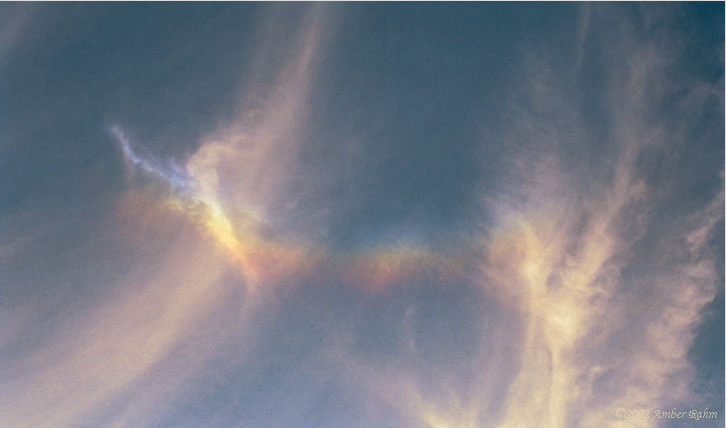Circumzenithal Arc Gallery
Circumzenithal Arc Gallery: A Spectacular Atmospheric Phenomenon
The mesmerizing beauty of the sky never fails to captivate us with its ever-changing displays. One such captivating phenomenon is the Circumzenithal Arc (CZA), an optical marvel that graces the heavens with its vibrant colors and ethereal appearance. In this article, we delve into the enchanting world of the CZA, exploring its characteristics, formation, and the various forms it can take.
Understanding the Circumzenithal Arc
The Circumzenithal Arc is a type of halo that appears as a colorful arc positioned above the sun in the sky. Often mistaken for a rainbow, this celestial spectacle is not caused by raindrops but rather by ice crystals in the atmosphere. These ice crystals, typically found in cirrus clouds, act as tiny prisms that refract sunlight, creating a stunning display of colors.
Formation of the Circumzenithal Arc
To understand how a CZA forms, we must first comprehend the process of refraction. When sunlight passes through ice crystals, it undergoes refraction, bending as it enters and exits the crystal. This bending causes the light to separate into its component colors, similar to how light disperses when passing through a prism. The result is a magnificent arc of vibrant hues suspended high in the sky.
The Anatomy of a Circumzenithal Arc
The CZA exhibits a distinct shape and color pattern that distinguishes it from other atmospheric phenomena. The arc appears convex, with its highest point directly above the sun. The colors present in a CZA are typically the same as those found in a rainbow: red on the outer edge and violet on the inner edge. However, unlike a rainbow, the CZA is often more intense and vibrant in color.
Variations of the Circumzenithal Arc
While the classic CZA displays a convex shape and follows the traditional color pattern, variations of this phenomenon can occur under specific atmospheric conditions. Some of these variations include:
-
Upside-Down Circumzenithal Arc: In rare cases, the CZA can appear upside-down, with the red color on the inner edge and violet on the outer edge. This reversal of colors creates a captivating and unusual sight in the sky.
-
Tangent Arc: Occasionally, a secondary arc known as the Tangent Arc may accompany the CZA. The Tangent Arc appears below the primary arc, forming a graceful curve that seems to touch it tangentially. This secondary arc adds an extra layer of beauty to an already awe-inspiring spectacle.
-
Supernumerary Rainbows: Sometimes, a series of faint, closely spaced arcs known as supernumerary rainbows may appear inside the CZA. These additional arcs enhance the overall visual impact, creating a truly mesmerizing experience for those fortunate enough to witness them.
Capturing the Beauty: Circumzenithal Arc Photography
Photographing a Circumzenithal Arc can be a rewarding experience for both amateur and professional photographers. To capture this celestial phenomenon in all its glory, it is essential to be prepared and equipped with the right tools. Here are some tips for photographing the CZA:
-
Location: Choose a location with unobstructed views of the sky to maximize your chances of spotting and capturing the CZA.
-
Timing: The best time to observe and photograph a CZA is when cirrus clouds are present in the sky. These high-altitude clouds are often thin and wispy, providing the ideal conditions for ice crystals to form and create the CZA.
-
Camera Settings: Set your camera to manual mode and adjust the exposure settings accordingly. Experiment with different shutter speeds and ISO settings to achieve the desired effect.
-
Composition: Consider incorporating interesting foreground elements into your composition to add depth and context to your CZA photograph.
Conclusion
The Circumzenithal Arc is a breathtaking atmospheric phenomenon that never fails to leave observers in awe. Its vibrant colors and graceful arc shape make it a true spectacle of nature. Understanding its formation and variations allows us to appreciate the intricacies of this optical marvel. So, next time you find yourself gazing at the sky, keep an eye out for the captivating beauty of the Circumzenithal Arc.

A circumzenithal arc shines in tangled cirrus. Photographed in Vermont, November '02 by Amber Rahm. �2002 Amber Rahm, reproduced with permission.
Note: this article has been automatically converted from the old site and may not appear as intended. You can find the original article here.
Reference Atmospheric Optics
If you use any of the definitions, information, or data presented on Atmospheric Optics, please copy the link or reference below to properly credit us as the reference source. Thank you!
-
<a href="https://atoptics.co.uk/blog/circumzenithal-arc-gallery-3/">Circumzenithal Arc Gallery</a>
-
"Circumzenithal Arc Gallery". Atmospheric Optics. Accessed on April 19, 2024. https://atoptics.co.uk/blog/circumzenithal-arc-gallery-3/.
-
"Circumzenithal Arc Gallery". Atmospheric Optics, https://atoptics.co.uk/blog/circumzenithal-arc-gallery-3/. Accessed 19 April, 2024
-
Circumzenithal Arc Gallery. Atmospheric Optics. Retrieved from https://atoptics.co.uk/blog/circumzenithal-arc-gallery-3/.